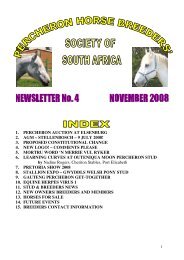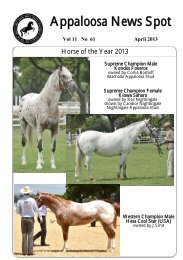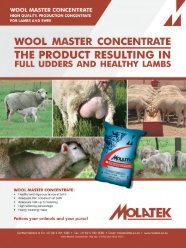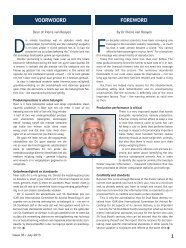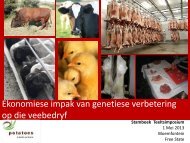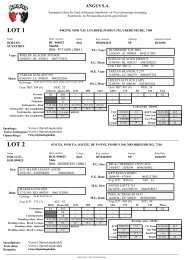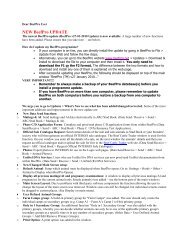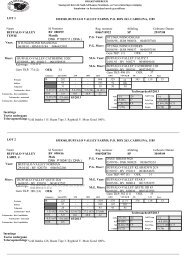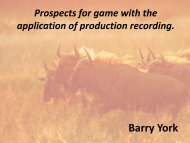Kliek hier vir bladsy 36-48 - SA Stamboek
Kliek hier vir bladsy 36-48 - SA Stamboek
Kliek hier vir bladsy 36-48 - SA Stamboek
Create successful ePaper yourself
Turn your PDF publications into a flip-book with our unique Google optimized e-Paper software.
More than just skin deep<br />
By Richard York<br />
One of the most important selection criteria that<br />
needs to be considered in wildebeest, as well as<br />
other game, is the colour of the hair and skin. An<br />
antelope’s skin refers to the whole area that covers<br />
its body and which is covered in hair. It is also the<br />
biggest organ in its body and comprises approximately 7 to 8% of<br />
the animal’s live mass.<br />
The skin is the shield between the antelope’s body and the<br />
external en<strong>vir</strong>onment. Thus the efficient functioning of this organ<br />
is of vital importance when the animal has to adapt to the<br />
circumstances to which he is exposed. The condition of the hair<br />
is also a direct reflection of the condition of the animal, and it<br />
indicates whether its hormone balance and nutritional status are<br />
in a good state.<br />
Buffalo with their dark skins rest in the shade for most of the day in order to<br />
avoid sunlight. (Photograph by Richard York)<br />
A heat regulator<br />
Another special characteristic of the skin is that it is the most<br />
important heat regulator of the animal. Wildebeest are warmblooded,<br />
and the speed and efficiency with which several mechanisms<br />
are implemented to neutralise the stress caused by heat<br />
and cold, is also an indication of the animal’s adaptability.<br />
Heat is released in the body on a continuous basis due to physiological<br />
and metabolic processes. The body needs to get rid of<br />
heat continuously in order to prevent an excessive increase in<br />
body temperature. The animal gets rid of heat through the following<br />
methods:<br />
• Radiation, conduction and convection.<br />
• Vaporisation of water from the skin and respiratory passages.<br />
• Excretion of faeces and urine.<br />
Sunlight’s enormous influence<br />
Radiation from the sun is intense in tropical areas and consists of<br />
rays in three different wavelengths:<br />
• Long wavelength – infrared or heat rays.<br />
• Medium wavelength – colours of the rainbow for which the<br />
eyes are very sensitive.<br />
• Shortwave or ultraviolet rays – invisible to the naked eye.<br />
It was found that the colour and hair type of an antelope have<br />
a direct influence on the efficiency of the reflection of both the<br />
infrared and light rays.<br />
Professor Jan Bonsma compiled a test to determine the reflection<br />
ability of Afrikaner cattle with different skin colours. Cream,<br />
light yellow, golden, light red, red and dark red skin colours were<br />
used in the test. It was clear from the tests that the lighter the animal’s<br />
skin colour, the more efficient its ability to reflect sunlight.<br />
More studies by Bonsma in the Mussina district showed that<br />
the influence of sunlight on a black cow during an 8,5-hour day<br />
is enough to boil 13 litres of water. Except for the heat generated<br />
A herd of wildebeest in the sunlight. (Photograph by Tamlyn Smith)<br />
by metabolic energy, animals must also get rid of an enormous<br />
amount of sun energy to maintain thermal equilibrium in a tropical<br />
en<strong>vir</strong>onment. Therefore buffalo which have a dark skin colour,<br />
must spend many hours during the day in deep shade and will<br />
rather graze and wallow in mud holes late in the evening, at night<br />
or during the early of the morning.<br />
Luckily the shortwave ultraviolet rays that cause cancer are<br />
reflected effectively by yellow, brown and black skin colours. It is<br />
therefore clear that a pigmented, light-coloured skin is the ideal<br />
combination to protect an animal against high temperatures and<br />
intense radiation.<br />
Golden Breeders believes it is not a coincidence that these<br />
highly adaptable colour variations of blue wildebeest occur naturally<br />
under the free-roaming wildebeest of the Limpopo River<br />
catchment area. The vegetation of this area is described as semisweet<br />
bushveld – one step away from the Kalahari desert, and it<br />
is one of the hottest, driest areas in South Africa.<br />
Golden Breeders believes that the golden wildebeest is proof<br />
that we are spectators of the process of evolution. Golden wildebeest<br />
are well adapted to resist climate change in an increasingly<br />
warmer and drier South Africa.<br />
(Adapted from the Golden Wildebeest Manual compiled by Golden<br />
Breeders.) SB<br />
38



